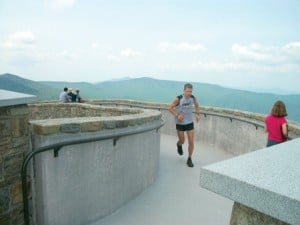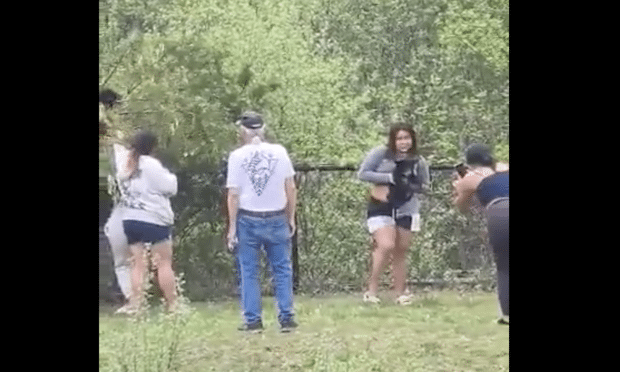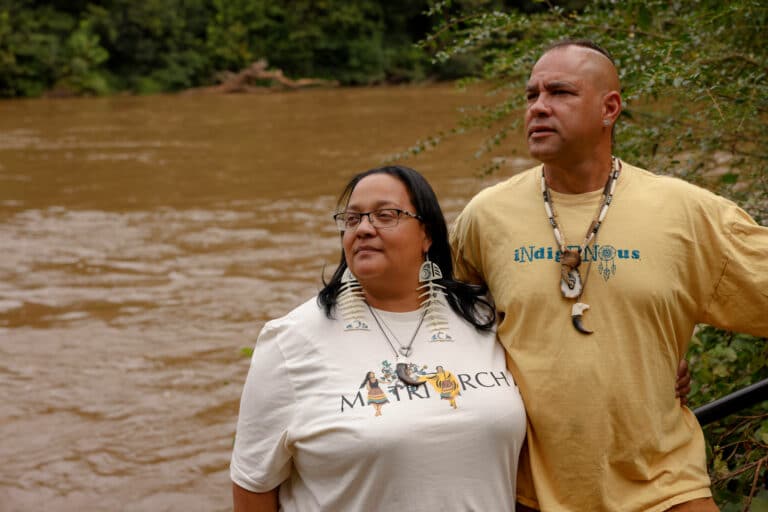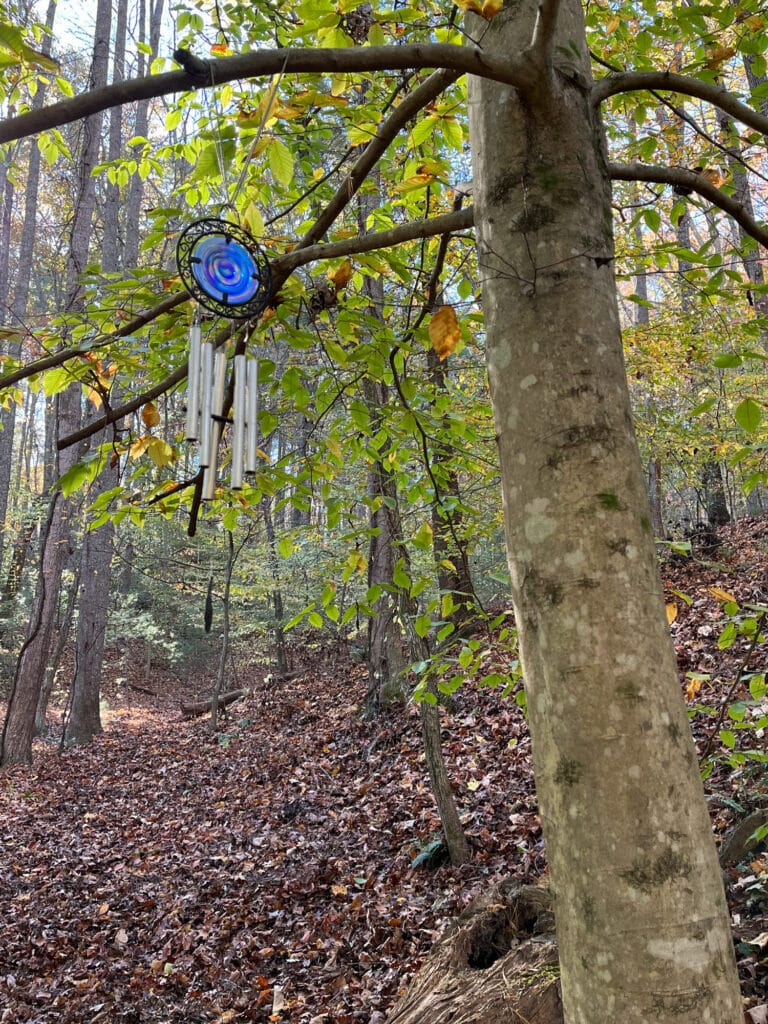He arrives at the final checkpoint just before 8 p.m. and swigs some Gatorade before heading off down the trail. Two miles to the finish, and he’s on record pace. He knows that if he can maintain for just a little bit longer, the record is his, and after fourteen hours in the woods, he’s ready to see that finish. Less than a half hour later, he’s there, having covered the 77-mile Cherokee Foothills Trail in 14 hours and 26 minutes, over two hours faster than the previous best.
The finish line of this journey is different than those of the many races he’s run. There’s no tape to break, no cheering crowd, no trophies or medals. Instead, he unceremoniously hits the stop button on his watch, checks his time, grabs a soda and hops in the car to head home. Once there, he may text a running buddy or maybe put a post on Facebook about his newly established Fastest Known Time (FKT).
Such was the scenario when my husband Mark Lundblad finished his record setting run on the Foothills Trail in upstate South Carolina. A bit anticlimactic, one might say. What would possess a person to put it on the line like that, to push him- or herself to the point of physical exhaustion, without the carrot of a race for motivation?
The past decade has seen a proliferation of races across the Southeast. Runners can choose from traditional road races ranging from 5Ks to marathons, or they can opt for off-road adventures – short or long trail races, Spartan obstacle courses, and ultras lasting twenty-four hours or more. There’s something for everyone, it seems, so why do some individuals choose to create adventures of their own?
“What drew me initially was the simplicity. It’s straightforward—here’s a trail with a start and finish point. It’s you and the trail—how quickly can you cover those miles?” says Matt Kirk, who holds a variety of speed records across the Southeast, including the Bartram Trail and the Benton-MacKaye Trail, as well as the unsupported Appalachian Trail record.
Many trail runners who got into the sport for the peace and tranquility of running in the woods find popular trail races to be a bit too crowded for their taste. Increasingly high entry fees and races that fill quickly or utilize lottery systems are also deterrents for some would-be competitors. FKTs give runners a chance to test themselves under the most simple and pure of conditions, avoiding all of the hoopla of a traditional race.

So what, exactly, is an FKT? The acronym stands for Fastest Known Time, an unofficial course record of sorts. Technically, a speed record can be established for any trail or course that an individual wishes to designate. FKTs can be as varied and original as the people who attempt them, although they are typically run start-to-finish on an entire established trail, on established or otherwise “classic” routes, or on mountaineering routes such as summit ascents. Some of the most widely known FKTs are the Appalachian Trail, the Pacific Crest Trail, Vermont’s Long Trail, and the Grand Canyon’s Rim-to-Rim-to-Rim. Not all of them are epic, multi-day affairs, however. Take Neil Gorman’s 20-mile circumnavigation of the Rivanna Trail in Charlottesville, Virginia, or his 7-mile Old Rag Loop. Both are reasonable distances that can be undertaken with minimal planning and logistics.
Gorman has intentionally chosen FKTs that are on familiar routes close to home. For him, FKTs provide an opportunity to challenge himself without the stress of a race. “I can be more flexible…if I’m feeling good and the weather is good, I’ll decide to go for it.” This approach removes many of the unpredictable aspects of an organized race – weather, worries about how he’ll feel on a given day, or the pressure of having other people sharing the trail. Gorman views speed record attempts as training runs, not as “A” goals, and says that his aim is to “up the game a bit among local trail runners” by challenging others to best his times. On his blog, he notes “running the RT (Rivanna Trail) for an FKT is an exercise in self-enjoyment but to do so in an inspiring or popular manner might create energy, a buzz even, within the running community and one that might draw positive awareness to the RT itself.”
Gorman has upped the ante for the Rivanna Trail FKT by offering an incentive to other runners. Following his record-setting run, he made a donation to the RT Foundation and pledged to make a similar donation in the name of whoever takes down his time. He would love to see this tradition continue, as a way of both supporting the trail and challenging others.
Whereas Gorman favors sub-ultra distance FKTs that can be accomplished without a great deal of planning, the logistical challenges are part of what draws Kirk to the pursuit of speed records. His runs can last anywhere from twenty hours to twenty days (or, in the case of his unsupported A.T. record, 58 days, 9 hours and 38 minutes). While many FKTs are established with the help of a support crew who might provide anything from food and drink to encouragement and company on the lonelier sections of the trail, Kirk prefers to be self-reliant. He describes a solitary effort as “more pure”, explaining that there is an art form to moving efficiently through the woods completely solo. He also notes that he sometimes feels guilty for roping in friends and family members to assist in yet another adventure, so going at it alone reduces stress on both him and his loved ones.
Another facet of FKTs that Kirk loves is the ability to explore natural areas that he might not otherwise get to experience, either because of their remote nature or due to regulations that would make a traditional trail race impossible. One of his favorites is the SCAR, or Smokies Challenge Adventure Run. This 72-mile run consists of a traverse of Great Smoky Mountains National Park via the Appalachian Trail. This run is particularly tough due to the inaccessibility of aid, as vehicular access is only possible at one point on the trail. This also means that once one sets off on this challenge, there are very few opportunities to bail. Kirk says that this forces him to step outside his comfort zone and become “intimately involved with the landscape”, which ultimately leads to growth as a person.
I experienced this personal growth firsthand on my solo run on the Foothills Trail a couple of years ago. I began my run in the predawn hours during a spring storm system that brought thunderstorms and tornadoes to the region. Running those initial miles in the wet darkness terrified me. Thinking that I was destined to slide off the side of the mountain, never to be heard from again, I found myself questioning my toughness – and my sanity. Who was I to attempt such a thing, and why hadn’t I just stuck with the safety and predictability of an organized race? I missed the reassurance that comes with seeing the flagging that marks a race course and knowing that other runners are out there too. I discovered that solitude, which I had always considered peaceful, could also be terrifying. I became convinced that I just didn’t have what it took to complete that adventure and vowed to end the foolishness as soon as I saw my husband at our predetermined meeting place, ten miles up the trail.
As you might imagine, once I reached our rendezvous spot, a new day was dawning. The sun was beginning to rise, and with it came a serious attitude adjustment. Although I knew that I still had a long way to travel, the psychological boost that was brought about by surviving those initial hours in the darkness gave me the confidence I needed to persevere. I still look back on that day, recalling the internal struggle that forced me to explore not only new wilderness territory but also an interior landscape that I never knew existed.
Kirk says he has experienced many ups and downs on the trail. He notes that the initial miles of an FKT are sometimes the worst. Adventurers frequently begin their attempts in the early morning hours before sunrise, and heading out into the dark unknown, with miles or days ahead of you, can be daunting. Ordinary shadows take on scary shapes, and noises always sound more threatening in the night. For an explorer like Kirk, this uncertainty and apprehension is invigorating. He loves the unpredictability of an FKT, saying “supported organized races are like coloring books while self-supported adventure runs are blank canvases.”

One of the good – and bad – things about an FKT attempt is that you get to make your own rules. In essence, you are your own race director, choosing the location, the distance, the date and time of your adventure. If the day comes and you’re just not feeling it, or the weather is a washout, no worries – try again tomorrow, or next week. On the other hand, this lack of accountability can make it awfully tempting to bail when the going gets rough. Whereas most runners will go to great lengths to avoid a DNF in a traditional race, once you take away the entry fee and the spectators, it becomes much easier to succumb to the urge to quit. Kirk says that he has entertained thoughts of stopping at least once in every speed record he has attempted. “It’s a good opportunity to assess things,” he says, asking himself “how bad is it really?” While most of the time the pain and discomfort are temporary and can be pushed through, there have been times that he has opted to abort his attempt. After all, he says, “we do this for pleasure…and sometimes it isn’t really pleasurable.”
If you feel ready to go out and attempt an FKT of your own, where do you begin?
Peter Bakwin, who along with fellow Coloradan Buzz Burrell, was one of the pioneers of the FKT movement in the 1990’s, has established the go-to website for all things FKT. Here you can find listings of FKTs around the country and the globe, along with guidelines for establishing a speed record and general discussions about the topic.
Burrell has proposed three basic guidelines for establishing an FKT:
Announce your intentions in advance. Pay your respects to those who came before you, and tell them what you intend to attempt and when.
Be an open book. Invite anyone to come and watch or, better yet, participate. This makes your effort more fun and any result more believable.
Record your event. Write down everything immediately upon completion. Memory doesn’t count.
Here in the Southeast, trail runner Jason Sullivan has established even more stringent criteria for verifying a finish (FKT or not) on the Foothills Trail in South Carolina. He requests that runners have witnesses to their attempt, that their support crew photograph them at various locations on the trail, and that they provide GPS data or at least split times to support their claims. Why the strict demands? Unfortunately as FKTs grow in popularity, the temptation for cheaters is present as well. What began as a pure and simple opportunity for an individual to test his or her speed, strength and endurance against the trail and the runners who preceded has in some cases turned into an ego-driven pursuit. Some blame this on the age of social media, in which even training runs end up tweeted or posted on Facebook. Sometimes it seems like a run isn’t even valued if it hasn’t been posted and commented upon, bringing to mind that age-old question about the sound made by a tree that falls in the forest.
So why bother? Why deal with logistics and documentation and the unknown? Why not just pay the entry fee for a race and let someone else handle all of the details? Runners like Neil Gorman and Matt Kirk consider an FKT to be the best of both worlds — an opportunity to explore new terrain and experience the solitude that only a solo trail run can provide while challenging oneself against the ghosts of trail runners past and setting new standards for those who will follow. As I learned myself, FKTs provide mental and emotional challenges to accompany the physical. Kirk concludes that FKTs “are not for everybody. Less support means more opportunity for error and greater consequences. But (there are) also opportunities for memories that last a lifetime.”
The South’s Epic FKTs
Cherokee Foothills Trail
Table Rock State Park to Oconee State Park, S.C.
According to Johnny Molloy, the Foothills Trail may be the most unsung, underused, and underrated long trail in the Southeast. It covers 77 miles, traversing the Cherokee Foothills of the Southern Appalachians in North and South Carolina, through state parks, national forests, and state-owned preserves. While aid is possible, there is no access through the 33 mile Laurel Valley section. FKT (male): 14:26 – Mark Lundblad; FKT (female): 20:47 – Anne Lundblad
Smokies Challenge Adventure Run
Great Smoky Mountains National Park, N.C./Tenn.
This is a remote 70+ mile traverse of the Great Smoky Mountains National Park along the Appalachian Trail, starting at Fontana Dam and going to Davenport Gap. The total elevation gain is 18,660. On-course aid and bail-out is only possible at 40 miles at Newfound Gap Road. The trail is technical, and there are a lot of steep climbs and descents, all on singletrack. FKT (supported): 14:50 – David Worth; FKT (unsupported): 15:40 – Will Harlan
Rivanna Trail
Charlottesville, VA
A series of footpaths, trails, and greenways within the Rivanna River watershed that link up to create a 20-mile loop around the town of Charlottesville. This is a good route for an FKT newbie, as there are many places to access support, but the trade-off is losing the wilderness aspect. FKT: 2:09:47 – Neil Gorman
Pitchell
Asheville, N.C.
This 67-mile trek is the brainchild of Asheville runner Adam Hill. It is run almost solely on the Mountains-to-Sea Trail from the top of Mount Pisgah to the summit of Mount Mitchell, the highest peak in the Eastern U.S. Over 16,000 feet of elevation gain and gnarly technical sections make this an epic run, but aid is available due to frequent Blue Ridge Parkway crossings. FKT: 13:28 – Mark Lundblad
Georgia Loop
North Georgia
Described as “the toughest hike in Georgia” due to its rugged and remote nature, this loop is the triangle formed by the Benton MacKaye Trail, the Duncan Ridge Trail and the A.T. Not for the faint-hearted, it includes one of the most difficult stretches of the Benton Mackeye Trail, which National Geographic has named one of the world’s “epic trails.” FKT: 12:35 – Richard Schick








